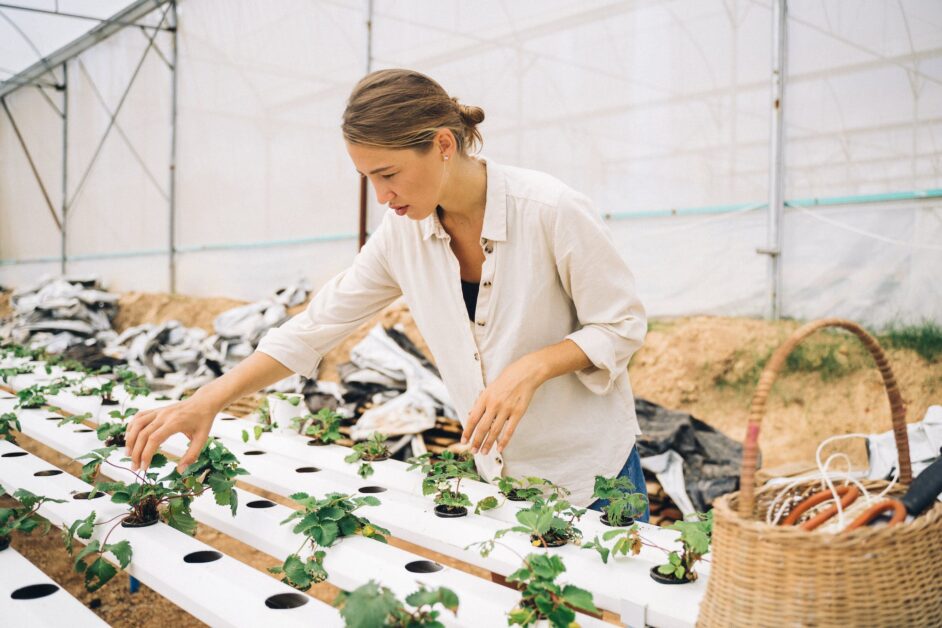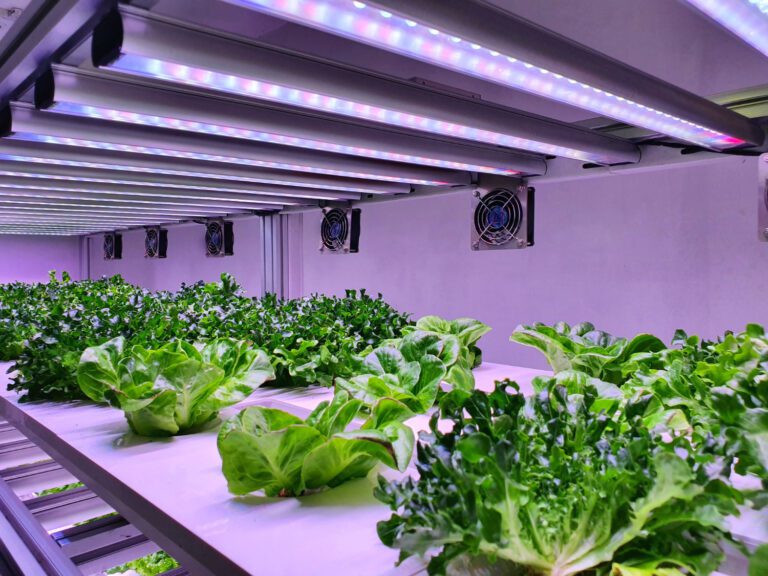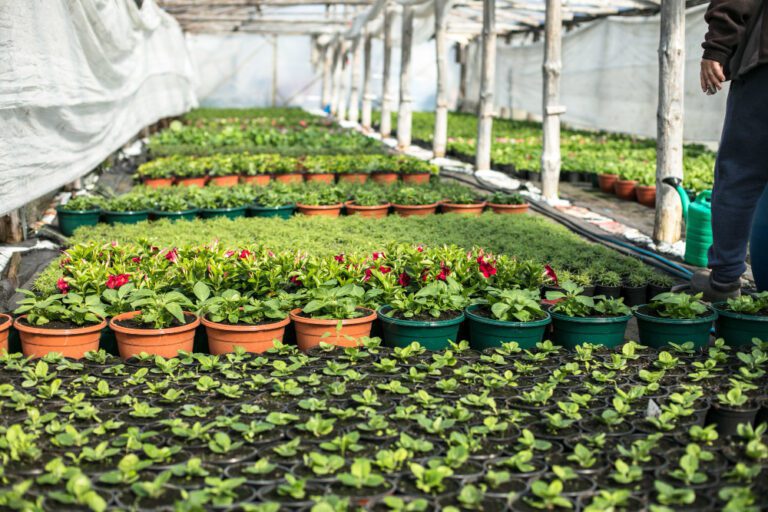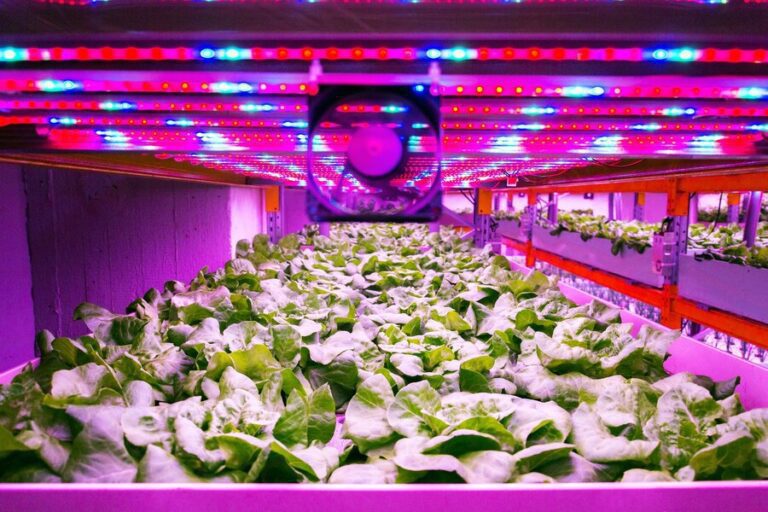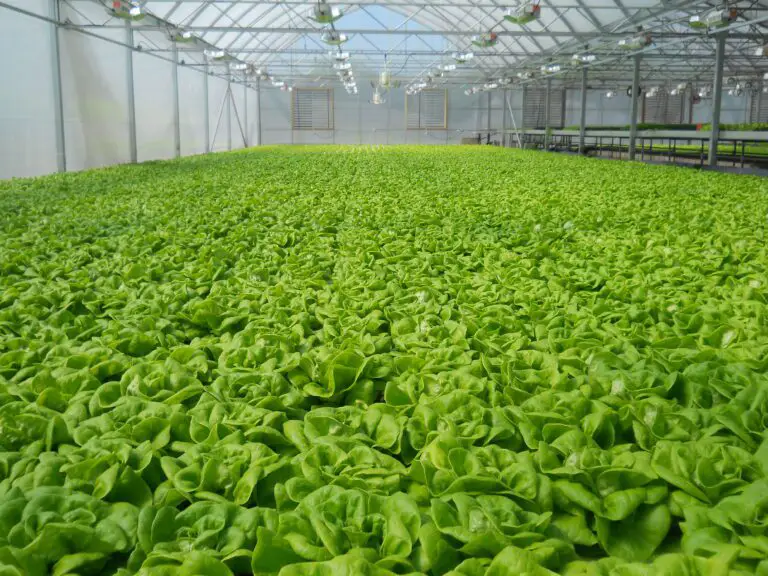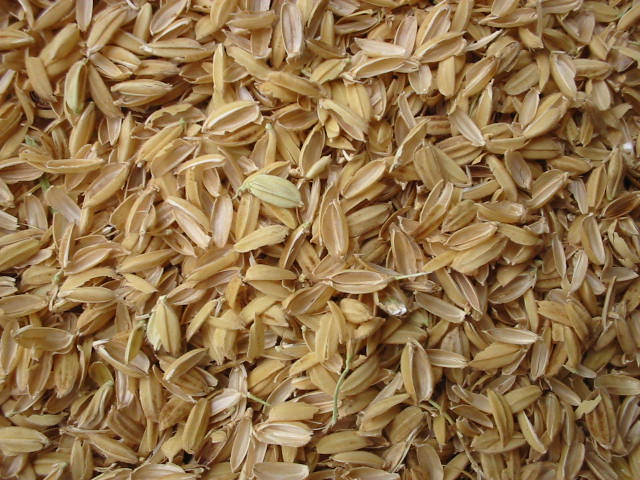Best Hydroponic System: How to Choose the Right One for Your Plants
A hydroponic system is a way of growing plants without soil, using water, nutrients, and a growing medium instead. Hydroponics has many advantages over traditional soil gardening, such as faster growth, higher yields, and better quality. However, there are also many types of hydroponic systems to choose from, each with its own pros and cons. How do you know which one is best for your plants?
In this article, we will explore the main features, benefits, and drawbacks of six common hydroponic systems: ebb and flow, deep water culture, aeroponics, drip, vertical, and NFT. By the end of this article, you will have a better understanding of how to choose the right hydroponic system for your plants
Table of Contents
Types of Hydroponic Systems: A Comprehensive Overview
When it comes to the best hydroponic systems, there are several different types to choose from, each with its unique advantages and characteristics. In this comprehensive overview, we will explore the most common types of hydroponic systems and how they work.
Deep Water Culture (DWC): In this system, the plant roots are suspended in a nutrient solution that is constantly aerated by an air pump. This system is simple, inexpensive, and suitable for fast-growing plants. However, it can also be prone to root rot, algae growth, and temperature fluctuations.
According to a study by the University of Arizona, hydroponic lettuce can yield up to 10.8 kg/m², while soil-grown lettuce can yield only 3.9 kg/m². Hydroponic basil can yield up to 6.2 kg/m², while soil-grown basil can yield only 0.8 kg/m².
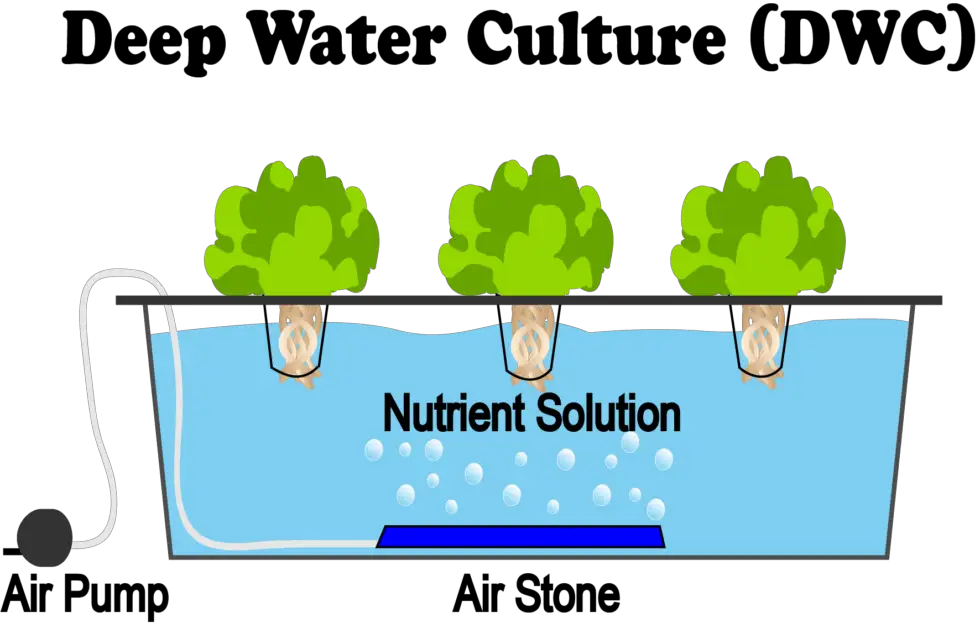
Ebb and Flow (Flood and Drain): In this system, the plant roots are placed in a growing medium that is periodically flooded with a nutrient solution and then drained. This system allows for more control over the moisture and oxygen levels of the roots. However, it also requires a reliable pump and timer, and can be affected by power outages or clogs.
The best crops to grow in ebb and flow systems are tomatoes, peppers, cucumbers, strawberries, and cannabis. These crops can produce higher yields and better quality in hydroponics than in soil. For example, hydroponic tomatoes can yield up to 41 kg/m², while soil-grown tomatoes can yield only 7 kg/m². Hydroponic cannabis can yield up to 1.2 lbs/plant, while soil-grown cannabis can yield only 0.4 lbs/plant.
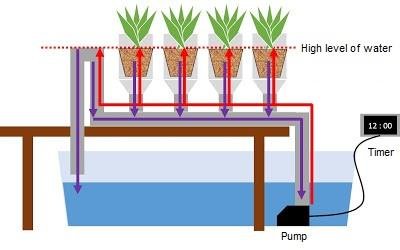
Drip Hydroponics: In this system, the plant roots are placed in a growing medium that is continuously or intermittently dripped with a nutrient solution. This system is versatile, efficient, and easy to adjust. However, it also requires a precise delivery system, and can be wasteful of water and nutrients if not recirculated.
The best crops to grow in drip systems are rosemary, oregano, thyme, mint, and chrysanthemum. These crops can benefit from the precise delivery of water and nutrients in hydroponics. For example, hydroponic rosemary can yield up to 2.5 kg/m², while soil-grown rosemary can yield only 0.5 kg/m². Hydroponic chrysanthemum can yield up to 3.6 kg/m², while soil-grown chrysanthemum can yield only 1.2 kg/m².
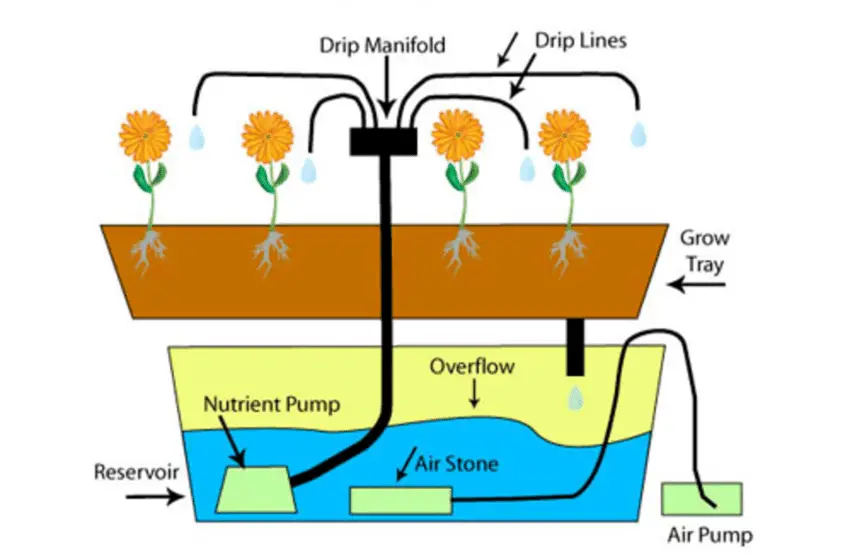
Nutrient Film Technique (NFT): In this system, the plant roots are placed in a shallow channel that has a thin film of nutrient solution flowing through it. This system is simple, space-efficient, and ideal for leafy greens and herbs. However, it also requires a constant flow of solution, and can be easily disrupted by power outages, pump failures, or root blockages.
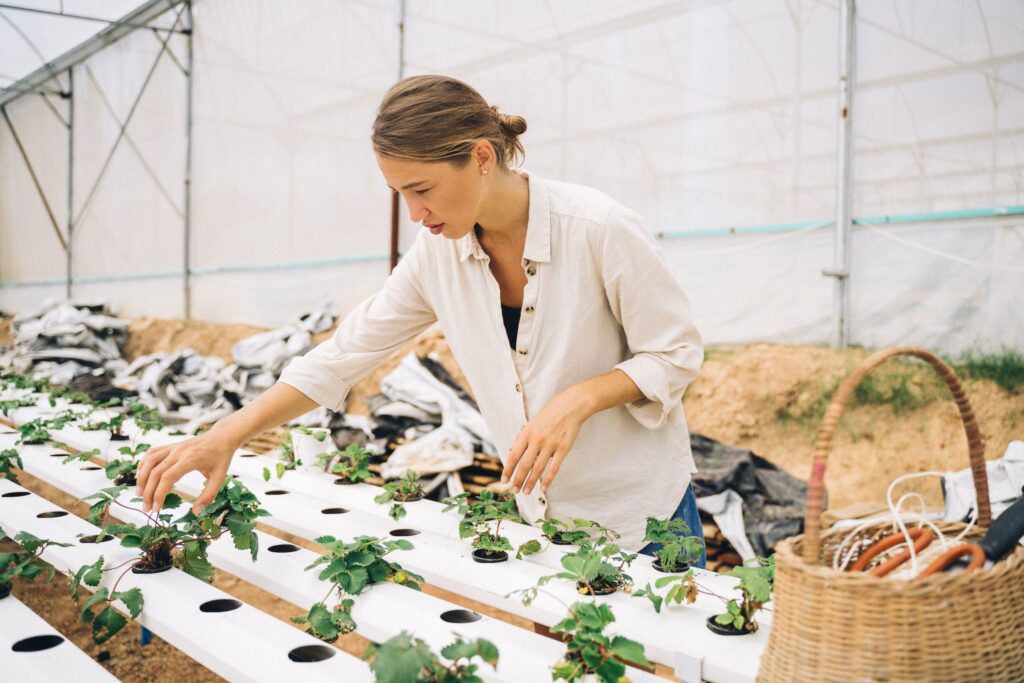
Aeroponics: In this system, the plant roots are exposed to air and sprayed with a fine mist of nutrient solution. This system provides the highest oxygen and nutrient uptake for the roots. However, it also requires a high-pressure pump and nozzle, and can be vulnerable to clogging, drying, or infection.
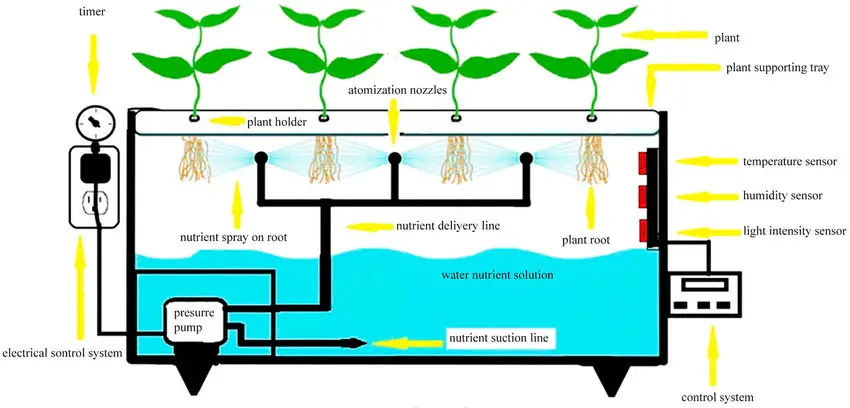
Aquaponics: In this system, the plant roots are placed in a growing medium that is connected to a fish tank. The fish waste provides the nutrients for the plants, and the plants filter the water for the fish. This system is sustainable, organic, and productive. However, it also requires a balance between the fish and plant populations, and can be complex and expensive to set up and maintain.
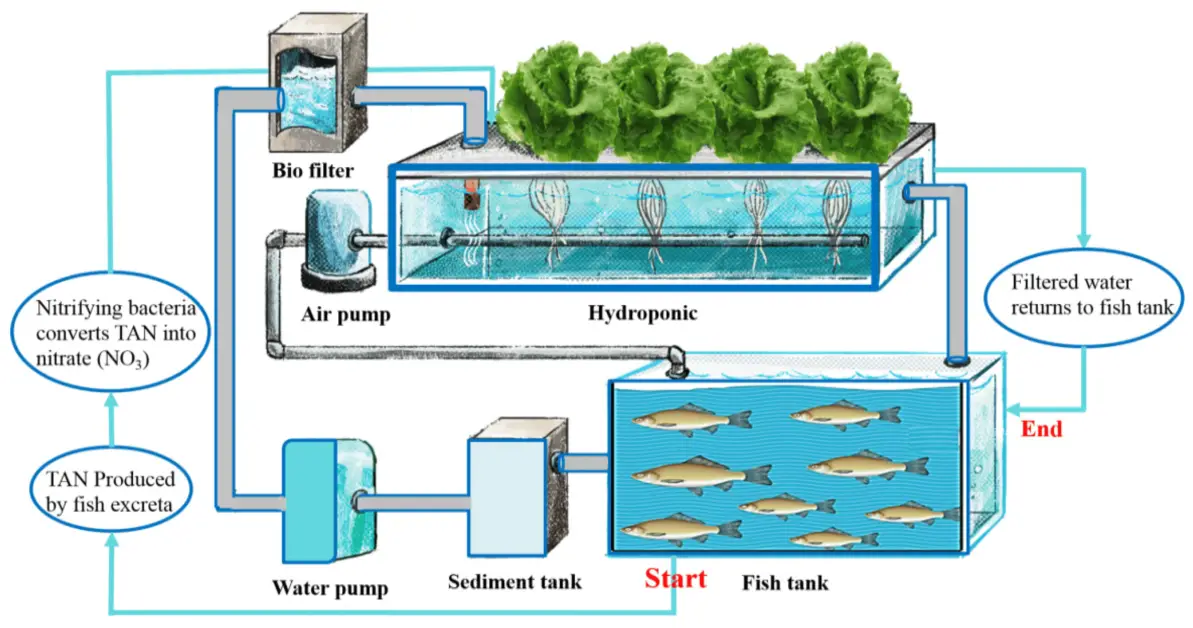
Aquaponics
Comparison of Hydroponic Systems
| System | Characteristics | Advantages | Disadvantages |
|---|---|---|---|
| Deep Water Culture (DWC) | Plant roots are suspended in a nutrient solution that is constantly aerated by an air pump | Simple, inexpensive, suitable for fast-growing plants | Prone to root rot, algae growth, temperature fluctuations |
| Ebb and Flow (Flood and Drain) | Plant roots are placed in a growing medium that is periodically flooded with a nutrient solution and then drained | Allows for more control over moisture and oxygen levels, can accommodate different plant sizes and types | Requires a reliable pump and timer, affected by power outages or clogs, risk of root rot or drying |
| Drip Hydroponics | Plant roots are placed in a growing medium that is continuously or intermittently dripped with a nutrient solution | Versatile, efficient, easy to adjust, can recirculate or reuse the solution | Requires a precise delivery system, can be wasteful of water and nutrients if not recirculated, risk of clogging or salt buildup |
| Aeroponics | Plant roots are exposed to air and sprayed with a fine mist of nutrient solution | Provides the highest oxygen and nutrient uptake, reduces water and nutrient usage, minimizes diseases and pests | Requires a high-pressure pump and nozzle, vulnerable to clogging, drying, or infection, affected by power outages or pump failures |
| Aquaponics | Plant roots are placed in a growing medium that is connected to a fish tank, where the fish waste provides the nutrients for the plants and the plants filter the water for the fish | Sustainable, organic, productive, eliminates the need for synthetic nutrients or pH adjustment | Requires a balance between fish and plant populations, complex and expensive to set up and maintain, sensitive to environmental changes or diseases |
| Nutrient Film Technique (NFT) | Plant roots are placed in a shallow channel that has a thin film of nutrient solution flowing through it | Simple, space-efficient, ideal for leafy greens and herbs, reduces water and nutrient usage | Requires a constant flow of solution, easily disrupted by power outages, pump failures, or root blockages, risk of drying or nutrient deficiency |
Factors to Consider Before Choosing a Hydroponic System
When it comes to choosing the right hydroponic system for your needs, there are several factors that you should consider. One of the most important factors is the type of plants you plan to grow. Different plants have different needs in terms of light, nutrients, and water. Some plants thrive in deep water culture systems, while others prefer nutrient film techniques or ebb and flow systems. Understanding the specific requirements of your plants is crucial in selecting the appropriate hydroponic system that will promote their optimal growth.
Another factor to consider is the space that you have available for your hydroponic setup. If you have limited space, vertical hydroponic systems or compact aeroponic systems may be a suitable choice for you. These systems are designed to maximize space utilization and can be easily installed in small rooms or balconies. On the other hand, if you have a larger area, you have more options to consider, such as nutrient film technique systems or Dutch bucket systems that allow for larger plant density. Assessing your available space and determining the size of the hydroponic system that will best fit it is essential for efficient and effective plant cultivation.
The third factor to consider is the frequency of maintenance you are willing to do. You should choose a system that matches your level of involvement and commitment. Some systems require more attention than others, such as changing the nutrient solution, checking the pH and EC levels, cleaning the reservoir and the pipes, and monitoring the plants for pests and diseases. You should also consider the reliability and durability of the system, as well as the availability of spare parts and technical support.
Understanding the Needs of Your Plants: Matching the Hydroponic System

When it comes to matching the right hydroponic system to the needs of your plants, there are a few key factors to consider. One of the most important aspects is the type of plants you are cultivating. Different plants have different requirements when it comes to nutrients, lighting, and space. For instance, leafy greens like lettuce and spinach thrive in nutrient film technique (NFT) systems, while fruiting plants such as tomatoes and peppers do well in deep water culture (DWC) systems. Understanding the specific needs of your plants will help you choose a hydroponic system that provides them with the optimal conditions for growth.
Another factor to consider is the growth stage of your plants. Seedlings and young plants have different needs compared to mature ones. For seedlings, a system that provides gentle and controlled watering, such as an ebb and flow system, can promote healthy root development. As plants mature, they may require more space and a different nutrient mix. The flexibility of certain best hydroponic systems, such as the nutrient film technique (NFT) or Dutch bucket systems, allows you to adjust the spacing and nutrient delivery to accommodate the changing needs of your plants throughout their growth cycle. By choosing a system that aligns with the growth stage of your plants, you can ensure optimal conditions for their development.
Matching the hydroponic system to the needs of your plants is crucial for their overall health and productivity. By considering factors such as plant type and growth stage, we have created a table with best hydroponic system for each plant.
| Plant | Best Hydroponic System |
|---|---|
| Basil | Deep Water culture or drip |
| Lettuce | Deep Water culture or NFT |
| Spinach | Deep Water culture or NFT |
| Bok Choy | Deep Water culture or NFT |
| Tomatoes | Drip or ebb and flow |
| Peppers | Drip or ebb and flow |
| Cucumber | Drip or ebb and flow |
| Celery | Deep Water culture or ebb and flow |
| Rosemary | Drip or ebb and flow |
| Oregano | Drip or ebb and flow |
| Strawberries | NFT or aeroponics |
| Kale | Deep Water culture or NFT |
| Chives | Deep Water culture or drip |
| Parsley | Deep Water culture or drip |
| Thyme | Deep Water culture or drip |
| Mint | Deep Water culture or drip |
| Chrysanthemum | Ebb and flow or drip |
| Carnation | Ebb and flow or drip |
| Orchid | Deep Water culture or aeroponics |
| Spider plant | Deep Water culture or ebb and flow |
| Pothos | Deep Water culture or ebb and flow |
Hydroponic System Size: Determining the Right Fit for Your Space
Choosing the right hydroponic system size is crucial for maximizing plant growth and optimizing space utilization. The size of your hydroponic system will depend on various factors, such as the number of plants you want to grow, the available space in your home or garden, and your cultivation goals.
One important consideration is the capacity of the hydroponic system to support the root systems of your plants. The root system is responsible for absorbing water, nutrients, and oxygen, so it’s essential to ensure that there is enough space for healthy root development. A system that is too small may restrict root growth and lead to stunted plants, while a system that is too large may waste resources and make maintenance challenging.
To determine the right fit for your space, it’s essential to assess the available area where you plan to set up your hydroponic system. Consider the dimensions of the space, including its width, length, and height. Remember to account for any obstacles or restrictions that may limit the size of your system, such as windows, doors, or ventilation systems. Additionally, think about the accessibility of the space for maintenance and harvesting purposes.
By carefully evaluating your available space, understanding the needs of your plants, and considering your cultivation goals, you can determine the optimal size for your hydroponic system. Whether you have a small indoor space or a large backyard, there are various hydroponic system sizes available on the market to suit your specific requirements. It’s always a good idea to consult with experts or professionals in the field to get personalized advice and recommendations based on your unique circumstances. Remember, finding the right fit is crucial for creating a thriving hydroponic garden that yields healthy and abundant crops.
Budget-friendly Hydroponic Systems: Finding an Affordable Option
Hydroponic systems have gained popularity for their ability to grow plants without the need for soil. However, the cost of setting up a hydroponic system can sometimes be a deterrent for many gardening enthusiasts. The good news is that there are budget-friendly options available that allow you to enjoy the benefits of hydroponics without breaking the bank.
One affordable option is the Deep-Water Culture (DWC) system. This simple and effective hydroponic method involves suspending the plant’s roots in a nutrient-rich solution. It requires minimal equipment, making it an excellent choice for beginners or those on a tight budget. Another budget-friendly system is the Nutrient Film Technique (NFT), which uses a thin film of nutrient solution flowing over the plant’s roots. This system is easy to set up and requires fewer nutrients and water compared to other methods.
When considering budget-friendly best hydroponic systems, there are a few factors to keep in mind. Firstly, consider the size of the system. If you have limited space, opting for a smaller system will not only save you money but also make it more manageable. Additionally, choose a system that matches the needs of your plants. Different plants have specific requirements, such as light and nutrient levels, so selecting a system that caters to those needs will ensure optimal growth. Finally, don’t forget to consider the maintenance costs associated with the system. Some systems may require more frequent nutrient changes or more specialized equipment, which can add up over time.
In conclusion, finding an affordable hydroponic system is achievable, even for those on a tight budget. By exploring options like Deep-Water Culture and Nutrient Film Technique systems, considering the size and needs of your plants, and considering long-term maintenance costs, you can find a budget-friendly hydroponic system that suits your needs. So don’t let cost be a barrier to enjoying the benefits of hydroponics – get started and watch your plants thrive!
DIY Hydroponic Systems: Building Your Own Setup
Building your own DIY hydroponic system is an exciting and rewarding project for any aspiring plant enthusiast. Not only does it allow you to have complete control over your plant’s environment, but it also gives you the opportunity to experiment with different setups and techniques. In this section, we will explore the steps involved in constructing your own hydroponic system, the materials you will need, and some common problems you may encounter along the way.

One of the first decisions you will need to make is the type of system you want to build. There are various options to choose from, such as DWC (Deep Water Culture), NFT (Nutrient Film Technique), or a drip system. Each system has its own advantages and disadvantages, so it’s important to do your research and select the one that best suits your needs and preferences. Once you have decided on the type of system, you can start gathering the necessary materials. This may include a reservoir for holding the nutrient solution, a grow tray or pots for housing the plants, a pump for circulating the solution, and an air stone or diffuser for providing oxygen to the roots. Additionally, you will need a pH tester, EC (Electrical Conductivity) meter, and appropriate nutrient solution to ensure the optimal growth of your plants.
As with any DIY project, it’s important to anticipate and address potential challenges. One common problem that hydroponic beginners encounter is nutrient imbalance. This can result in stunted growth, yellowing leaves, or even plant death. To prevent this, it’s crucial to regularly monitor and adjust the pH and EC levels of your nutrient solution. Another potential issue is root rot, which can occur if the roots are constantly submerged in water without sufficient oxygen. To combat this, consider implementing an air pump or incorporating an oxygenation system into your setup. Additionally, disease and pests can also pose a threat to hydroponic systems. Regularly inspect your plants for any signs of infestation or infection, and take appropriate measures to address them. By staying vigilant and proactive, you can mitigate these challenges and ensure a thriving hydroponic garden.
Hydroponic Systems for Small Spaces: Maximizing Limited Area
Hydroponic systems are a game-changer for anyone looking to grow their plants in small spaces. Whether you have limited room in your apartment, a balcony, or even just a countertop, the best hydroponic systems can help you maximize your gardening potential. These innovative systems allow for plants to grow without soil, using water infused with nutrients instead.
One of the main advantages of hydroponic systems for small spaces is their efficient use of space. Traditional gardening requires ample space for soil and roots to spread out, but hydroponic systems eliminate the need for soil altogether. Instead, plants are grown in nutrient-rich water solutions or inert mediums such as perlite or coconut coir. This allows for more plants to be grown in a smaller area, making it ideal for those with limited space.
Another benefit of hydroponic systems for small spaces is the ability to control the growing environment. With a hydroponic system, you have complete control over the temperature, humidity, and lighting conditions your plants are exposed to. This allows you to create the optimal growing conditions for your plants, maximizing their growth and yield. Additionally, because hydroponic systems provide a controlled environment, you can grow plants year-round, regardless of the outdoor climate.
Despite these advantages, there are also some challenges to consider when using hydroponic systems in small spaces. One common concern is the amount of space required for the system itself. While hydroponic systems use less space for plant roots compared to traditional gardening, the equipment, such as pumps, reservoirs, and grow lights, can still take up a significant amount of space. It’s important to carefully plan and choose a system that fits your available space without overcrowding it.
In conclusion, hydroponic systems offer a revolutionary solution for maximizing gardening in small spaces. With their space-efficient design and ability to control the growing environment, hydroponic systems allow you to grow a wide variety of plants in even the tightest of spaces. However, it’s important to consider the space requirements of the system itself and choose a setup that fits your allotted area. By taking these factors into account, you can successfully create a thriving hydroponic garden in your small space.
Choosing the Right Medium for Your Hydroponic System
Choosing the right medium for your hydroponic system is crucial for the success of your plants. The medium serves as a support structure for the roots, holding them in place and allowing for the exchange of oxygen and nutrients. There are several types of mediums to choose from, each with its own advantages and considerations.
One popular medium is Rockwool, which is made from molten rock or recycled slag. It has excellent water retention and aeration properties, allowing for optimal root growth. Rockwool also provides a neutral pH environment, which is beneficial for many plants. However, it is important to handle Rockwool with care as its fibrous nature can irritate the skin and respiratory system.
Another option is coconut coir, which is derived from the outer husk of coconuts. It is a renewable and sustainable medium that is becoming increasingly popular among hydroponic enthusiasts. Coconut coir offers excellent water retention and aeration, promoting healthy root development. It also has a slightly acidic pH, making it suitable for a wide range of plant species. It is worth noting that coconut coir may need to be pre-washed to remove excess salts and ensure optimal nutrient uptake by the plants.

When choosing a medium, it’s also important to consider the specific needs of your plants. Some plants, such as lettuce and greens, thrive in lightweight mediums like perlite or vermiculite, which offer good aeration and drainage. Others, such as tomatoes and cucumbers, benefit from heavier mediums like expanded clay pellets or growstones, which provide stability and support for larger plants.
In conclusion, selecting the right medium for your hydroponic system is a key factor in achieving healthy plant growth. Whether you opt for Rockwool, coconut coir, or other mediums, it’s important to consider factors such as water retention, aeration, pH levels, and the specific requirements of your plants. Experimentation and research can help you find the perfect medium that suits your needs and ensures thriving plants in your hydroponic system.
Hydroponic Nutrients: Essential Elements for Plant Growth
When it comes to hydroponic systems, one key component for successful plant growth is the use of proper nutrients. Unlike traditional soil-based gardening, hydroponic systems rely on a nutrient solution to provide plants with the essential elements they need to thrive. These essential nutrients include macronutrients such as nitrogen (N), phosphorus (P), potassium (K), calcium (Ca), magnesium (Mg), and sulfur (S), as well as trace elements like iron (Fe), manganese (Mn), zinc (Zn), copper (Cu), molybdenum (Mo), and boron (B).
One common question that arises about hydroponic nutrients is how to choose the right formula for specific plants. Different plants have different nutrient requirements, so it’s essential to match the nutrient solution to the needs of your plants. Many commercial hydroponic nutrient solutions are tailored to specific plant types or growth stages, making it easier to provide the right balance of nutrients. However, it’s also important to monitor the nutrient levels in your system regularly and make adjustments as needed to ensure optimal plant health. By being attentive to your plants’ nutrient requirements and providing them with the necessary elements, you can maximize their growth and yield in your hydroponic system.
Hydroponic Lighting: Providing Optimal Light for Your Plants
Hydroponic lighting is a crucial element in providing optimal light for plants grown in a hydroponic system. Because plants in a hydroponic setup rely solely on artificial light for their growth, it is essential to choose the right lighting system to ensure successful cultivation.
One of the most commonly used types of hydroponic lighting is LED (Light Emitting Diode) lights. LED lights have gained popularity due to their energy efficiency and ability to produce the specific light spectrum needed for plant growth. They emit wavelengths that perfectly match photosynthetic requirements, promoting healthy plant development throughout their life cycle.
Another popular option is high-intensity discharge (HID) lights, which include metal halide (MH) and high-pressure sodium (HPS) lights. MH lights produce a bluish light spectrum ideal for the vegetative stage of plant growth, while HPS lights emit a reddish-orange spectrum suitable for flowering and fruiting stages. HID lights are known for their high light output, making them a favorite among commercial growers.
When choosing hydroponic lighting, it is important to consider the light intensity, color spectrum, and coverage area needed for your plants. Light intensity is measured in foot-candles or lux, and different plant species have varying light requirements. For example, leafy greens generally thrive with lower light intensity than fruiting plants like tomatoes. The color spectrum of the lighting system should provide the necessary wavelengths for photosynthesis, including red and blue light. Lastly, ensure that the lighting system can cover the entire grow area evenly to prevent any light deficiency or excess.
To further enhance the efficiency of hydroponic lighting, light movers or light reflectors may be used. Light movers can increase light distribution across the entire grow area, reducing the chances of plants receiving uneven light and leading to more uniform growth. Light reflectors, on the other hand, help maximize light absorption by reflecting it back onto the plants, increasing the overall light intensity.
Remember, proper lighting is vital to the success of your hydroponic crops. By choosing the right lighting system and understanding the specific needs of your plants in terms of light intensity, color spectrum, and coverage area, you can ensure optimal growth and abundant harvests.
Water Management in Hydroponic Systems: Maintaining Proper pH and EC
One of the key aspects of maintaining a successful hydroponic system is proper water management, specifically in relation to maintaining the correct pH and electrical conductivity (EC) levels. pH and EC levels play a crucial role in the growth and development of plants, as they directly affect nutrient uptake and overall plant health. Achieving and maintaining the ideal pH and EC levels requires careful monitoring and adjustment.
The pH level of the nutrient solution determines the availability and absorption of essential nutrients by the plants’ roots. In hydroponic systems, it is recommended to maintain the pH level within a specific range depending on the type of plant being cultivated. Most plants prefer a slightly acidic environment, with a pH range of 5.5 to 6.5. Regular monitoring of pH levels using pH testing kits or digital meters is essential to ensure the pH remains within the desired range. If the pH level is too high or too low, it can result in nutrient deficiencies or toxicities, which can stunt plant growth or cause other problems. To adjust the pH level, pH adjusters such as pH up or pH down solutions can be used. These solutions are added to the nutrient reservoir in small quantities and mixed thoroughly to bring the pH to the desired level.
In addition to pH, the electrical conductivity (EC) of the nutrient solution is another important factor in water management. EC measures the concentration of dissolved salts in the nutrient solution, which directly affects the nutrient availability to the plants. Monitoring EC levels helps ensure that the nutrient solution contains the appropriate blend of essential elements. Most hydroponic systems require an EC range between 1.8 and 2.5 depending on the stage of plant growth. High EC levels can indicate an excessive concentration of nutrients, which can lead to nutrient burn or other problems. On the other hand, a low EC level may signal a deficiency in essential nutrients. Adjusting the EC level involves adding more nutrient solution or diluting the existing solution to bring it within the desired range. Regular monitoring of both pH and EC levels and making necessary adjustments is crucial to maintaining a balanced and optimal environment for plant growth in hydroponic systems.
By ensuring proper pH and EC levels in your hydroponic system, you are providing an ideal environment for the plants to thrive and maximize their growth potential. It is important to note that different plants have specific pH and EC requirements, so it is essential to understand the needs of your particular crop. Regular monitoring, precise adjustments, and maintaining a balanced nutrient solution play a significant role in successful water management in the best hydroponic systems. In the next section, we will explore the various tools and techniques available to facilitate accurate pH and EC monitoring and offer practical solutions to common water management challenges. Stay tuned!
Hydroponic System Maintenance: Tips for Keeping Your Setup in Top Shape
Hydroponic systems, like any other gardening setup, require regular maintenance to keep them running smoothly and ensure optimal plant growth. Neglecting system maintenance can lead to nutrient deficiencies, pH imbalances, and even the spread of diseases. Fortunately, with a few simple tips, you can keep your hydroponic setup in top shape and enjoy vibrant, healthy plants.
One of the most important aspects of hydroponic system maintenance is monitoring and adjusting nutrient levels. Nutrient solutions provide essential elements for plant growth, so it’s crucial to ensure that they are properly balanced. Regularly check the pH and electrical conductivity (EC) levels of your nutrient solution using a pH meter and an EC meter. Aim for a pH level between 5.5 and 6.5 and an EC level suitable for your plant’s specific requirements. Adjust the nutrient solution accordingly by adding pH up or down solutions or diluting the solution with water to achieve the desired levels. Regularly monitoring and adjusting nutrient levels will prevent nutrient imbalances and promote healthy plant growth.
Another important aspect of hydroponic system maintenance is cleaning and disinfecting the system. Over time, algae, fungi, and other pathogens can build up in your hydroponic system and negatively impact plant health. To prevent disease outbreaks, it’s crucial to regularly clean and disinfect your system. Start by emptying the nutrient solution and scrubbing the reservoir and all components with a mild detergent or hydrogen peroxide solution. Rinse everything thoroughly with clean water before refilling the system with fresh nutrient solution. Additionally, it’s important to regularly inspect and clean the roots of your plants. Removing any dead or decaying roots will prevent the buildup of harmful bacteria and maintain healthy root growth. By practicing good cleanliness and hygiene in your hydroponic system, you can prevent disease and ensure the longevity and success of your plants.
Troubleshooting Common Issues in Hydroponic Systems
Best hydroponic systems offer many benefits, but like any method of plant cultivation, they can sometimes encounter problems. Understanding and addressing these common issues is crucial to ensure the success of your hydroponic setup.
One of the most prevalent problems is nutrient deficiency or excess. Nutrients are an essential component of hydroponic systems, and maintaining the proper balance is vital for healthy plant growth. If you notice that your plants are showing signs of nutrient deficiency, such as yellowing leaves or stunted growth, it may be time to reassess your nutrient solution. Conduct regular pH and EC (Electrical Conductivity) tests to ensure that the nutrient levels are within the optimal range for your particular plant species. Adjusting the nutrient concentration or pH levels accordingly can help resolve these issues.
Expanding Your Hydroponic System: Scaling Up for More Plants
As you gain experience with hydroponics and find success with your initial setup, you may start to think about expanding your hydroponic system to accommodate more plants. Scaling up can be an exciting prospect, but it does require careful planning and consideration. In this section, we will explore the various factors you need to take into account when expanding your hydroponic system to ensure the continued success of your plants.
One key factor to consider when scaling up your hydroponic system is the available space. Determine how much room you have for additional plant sites and whether you need to adjust the layout to maximize efficiency. Consider the height of your grow space as well, as certain plants may require more vertical clearance. It may be necessary to invest in additional shelving or lighting systems to accommodate the increased number of plants. Additionally, think about how the expansion will impact airflow and ventilation within your setup. Proper air circulation is crucial in preventing the growth of mold and disease, so be sure to make any necessary adjustments to avoid such issues.
Future Trends in Hydroponic Systems: What to Look Out For
The field of hydroponics has witnessed rapid advancements in recent years, and this trend is expected to continue in the future. As more people become interested in sustainable gardening and year-round crop production, the demand for innovative hydroponic systems is on the rise. In this section, we will explore some of the future trends in hydroponic systems that you should look out for.
One of the notable future trends in hydroponics is the integration of technology and automation. With the advancement of smart sensors, monitoring devices, and control systems, growers can now remotely monitor and optimize their hydroponic systems. These systems can automatically adjust factors such as nutrient levels, pH, temperature, and light intensity based on the specific needs of the plants. This not only improves efficiency and productivity but also minimizes human error and reduces the overall labor required. Imagine being able to manage your hydroponic system from anywhere in the world using just your smartphone!
Another exciting trend is the development of vertical farming systems. As urban areas continue to expand and available land becomes scarce, vertical farming offers a viable solution for maximizing crop production in limited spaces. Vertical hydroponic systems utilize stacked growing layers to utilize vertical space effectively. With advancements in LED lighting, vertical farming can now achieve optimum light distribution and energy efficiency. This trend not only allows for increased yields but also contributes to the reduction of transportation costs and carbon footprint, as produce can be grown closer to consumers in urban environments.
The future of hydroponic systems looks promising, as technology continues to evolve and address the challenges of sustainable agriculture. From smart automation to vertical farming, these trends offer exciting possibilities for both commercial growers and hobbyists. As a hydroponic enthusiast, keeping an eye on emerging trends can help you stay ahead of the curve and take full advantage of the latest innovations in this ever-evolving field. So, what are you waiting for? Stay tuned and get ready to embrace the future of hydroponics!
FAQs
What are some future trends in hydroponic systems?
Some future trends in hydroponic systems include the use of vertical farming to maximize space, the integration of automation and smart technology for improved efficiency, and the development of sustainable and environmentally friendly systems.
Are There Any Hydroponic Systems Specifically Designed For Commercial Use?
Are there any hydroponic systems specifically designed for commercial use?
Yes, there are hydroponic systems specifically designed for commercial use. These systems often have larger capacities and are built to handle the needs of a larger-scale operation.
Can I Use Hydroponic Systems To Grow Plants Indoors?
Yes, hydroponic systems are perfect for indoor gardening. They provide a controlled environment, allowing you to grow plants year-round without the need for soil.
How Do I Determine The Right Size Hydroponic System For My Space?
To determine the right size hydroponic system for your space, consider the available area, the number of plants you want to grow, and your budget. You can choose from compact systems for smaller spaces or larger systems for bigger areas.
Are there budget-friendly hydroponic systems available?
Yes, there are budget-friendly hydroponic systems available. Look for simple and compact systems or consider building your own DIY setup using readily available materials.
What Is The Best Medium To Use In A Hydroponic System?
The best medium to use in a hydroponic system depends on the type of plants you are growing. Common mediums include perlite, vermiculite, coconut coir, and rockwool. Research the specific needs of your plants to determine the most suitable medium.
Are hydroponic nutrients necessary for plant growth?
Yes, hydroponic nutrients are essential for plant growth in a hydroponic system. Since the plants are not grown in soil, all of their required nutrients must be provided through the nutrient solution.
How Important Is Proper Water Management In Hydroponic Systems?
Proper water management is crucial in hydroponic systems. Maintaining the correct pH and electrical conductivity (EC) levels is essential for the plants’ nutrient uptake and overall health.
How Can I Troubleshoot Common Issues In My Hydroponic System?
Common issues in hydroponic systems can include nutrient deficiencies, pH imbalances, and pest infestations. To troubleshoot these problems, regularly monitor your plants, water quality, and nutrient levels, and take appropriate corrective actions.
Can I expand my hydroponic system to accommodate more plants?
Common issues in hydroponic systems can include nutrient deficiencies, pH imbalances, and pest infestations. To troubleshoot these problems, regularly monitor your plants, water quality, and nutrient levels, and take appropriate corrective actions.
Can I Expand My Hydroponic System To Accommodate More Plants?
Yes, you can expand your hydroponic system to accommodate more plants. Many hydroponic systems are designed with modularity in mind, allowing you to add more units or modules as needed.
How can I keep my hydroponic system well-maintained?
To keep your hydroponic system in top shape, regularly clean and disinfect the system, monitor and adjust nutrient levels, check for any clogs or blockages, and inspect the plants for any signs of disease or nutrient deficiencies.

Suyash Dhoot, editor at SouthElMonteHydroponics.com, is a pioneering force in hydroponics. His expertise spans nutrient solutions and cutting-edge technology. Through meticulous editing, he elevates the site to a beacon of knowledge, offering invaluable insights. Dhoot’s dedication shapes a greener, more efficient future for agriculture.

